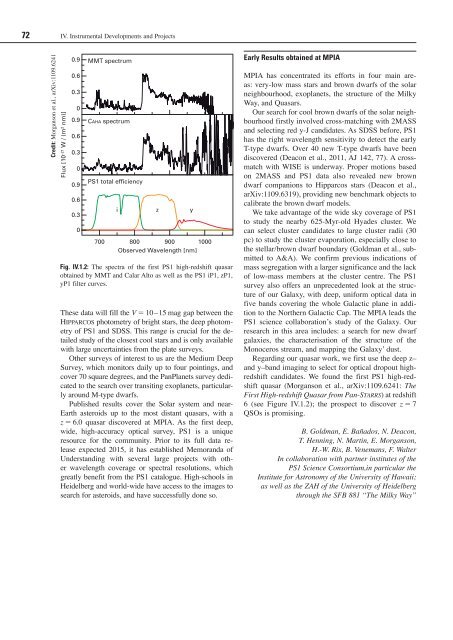Annual Report 2011 Max Planck Institute for Astronomy
Annual Report 2011 Max Planck Institute for Astronomy
Annual Report 2011 Max Planck Institute for Astronomy
You also want an ePaper? Increase the reach of your titles
YUMPU automatically turns print PDFs into web optimized ePapers that Google loves.
72 IV. Instrumental Developments and Projects<br />
Credit: Morganson et al., arXiv:1109.6241<br />
Flux [10 –21 W / (m 2 nm)]<br />
0.9<br />
0.6<br />
0.3<br />
0<br />
0.9<br />
0.6<br />
0.3<br />
0<br />
0.9<br />
0.6<br />
0.3<br />
0<br />
MMT spectrum<br />
CAHA spectrum<br />
PS1 total efficiency<br />
700<br />
i z y<br />
800 900 1000<br />
Observed Wavelength [nm]<br />
Fig. IV.1.2: The spectra of the first PS1 high-redshift quasar<br />
obtained by MMT and Calar Alto as well as the PS1 iP1, zP1,<br />
yP1 filter curves.<br />
These data will fill the V 10–15 mag gap between the<br />
Hipparcos photometry of bright stars, the deep photometry<br />
of PS1 and SDSS. This range is crucial <strong>for</strong> the detailed<br />
study of the closest cool stars and is only available<br />
with large uncertainties from the plate surveys.<br />
Other surveys of interest to us are the Medium Deep<br />
Survey, which monitors daily up to four pointings, and<br />
cover 70 square degrees, and the PanPlanets survey dedicated<br />
to the search over transiting exoplanets, particularly<br />
around M-type dwarfs.<br />
Published results cover the Solar system and near-<br />
Earth asteroids up to the most distant quasars, with a<br />
z 6.0 quasar discovered at MPIA. As the first deep,<br />
wide, high-accuracy optical survey, PS1 is a unique<br />
resource <strong>for</strong> the community. Prior to its full data release<br />
expected 2015, it has established Memoranda of<br />
Understanding with several large projects with other<br />
wavelength coverage or spectral resolutions, which<br />
greatly benefit from the PS1 catalogue. High-schools in<br />
Heidelberg and world-wide have access to the images to<br />
search <strong>for</strong> asteroids, and have successfully done so.<br />
Early Results obtained at MPIA<br />
MPIA has concentrated its ef<strong>for</strong>ts in four main areas:<br />
very-low mass stars and brown dwarfs of the solar<br />
neighbourhood, exoplanets, the structure of the Milky<br />
Way, and Quasars.<br />
Our search <strong>for</strong> cool brown dwarfs of the solar neighbourhood<br />
firstly involved cross-matching with 2MASS<br />
and selecting red y-J candidates. As SDSS be<strong>for</strong>e, PS1<br />
has the right wavelength sensitivity to detect the early<br />
T-type dwarfs. Over 40 new T-type dwarfs have been<br />
discovered (Deacon et al., <strong>2011</strong>, AJ 142, 77). A crossmatch<br />
with WISE is underway. Proper motions based<br />
on 2MASS and PS1 data also revealed new brown<br />
dwarf companions to Hipparcos stars (Deacon et al.,<br />
arXiv:1109.6319), providing new benchmark objects to<br />
calibrate the brown dwarf models.<br />
We take advantage of the wide sky coverage of PS1<br />
to study the nearby 625-Myr-old Hyades cluster. We<br />
can select cluster candidates to large cluster radii (30<br />
pc) to study the cluster evaporation, especially close to<br />
the stellar/brown dwarf boundary (Goldman et al., submitted<br />
to A&A). We confirm previous indications of<br />
mass segregation with a larger significance and the lack<br />
of low-mass members at the cluster centre. The PS1<br />
survey also offers an unprecedented look at the structure<br />
of our Galaxy, with deep, uni<strong>for</strong>m optical data in<br />
five bands covering the whole Galactic plane in addition<br />
to the Northern Galactic Cap. The MPIA leads the<br />
PS1 science collaboration’s study of the Galaxy. Our<br />
research in this area includes: a search <strong>for</strong> new dwarf<br />
galaxies, the characterisation of the structure of the<br />
Monoceros stream, and mapping the Galaxy’ dust.<br />
Regarding our quasar work, we first use the deep z–<br />
and y–band imaging to select <strong>for</strong> optical dropout highredshift<br />
candidates. We found the first PS1 high-redshift<br />
quasar (Morganson et al., arXiv:1109.6241: The<br />
First High-redshift Quasar from Pan-StarrS) at redshift<br />
6 (see Figure IV.1.2); the prospect to discover z 7<br />
QSOs is promising.<br />
B. Goldman, E. Bañados, N. Deacon,<br />
T. Henning, N. Martin, E. Morganson,<br />
H.-W. Rix, B. Venemans, F. Walter<br />
In collaboration with partner institutes of the<br />
PS1 Science Consortium,in particular the<br />
<strong>Institute</strong> <strong>for</strong> <strong>Astronomy</strong> of the University of Hawaii;<br />
as well as the ZAH of the University of Heidelberg<br />
through the SFB 881 “The Milky Way”
















